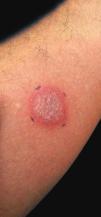Cutaneous tuberculosis is a rare form of extrapulmonary tuberculosis, comprising 1-2% of cases. Caused by Mycobacterium tuberculosis or related strains, it presents a wide range of clinical manifestations, mimicking other chronic dermatoses and leading to delayed diagnosis. A case of scrofuloderma is reported, whose diagnosis and treatment were only made six years after onset of the disease.
In Brazil, an average of 10,800 cases per year of extrapulmonary tuberculosis were reported from 2012 to 2015.1 An average of 227 cases of cutaneous tuberculosis are reported annually. Cutaneous tuberculosis can be caused by Mycobacterium tuberculosis, M. bovis, or the Calmette-Guérin bacillus (BCG). Scrofuloderma and lupus vulgaris are the most prevalent forms, but the occurrence oscillates according to geographic location and age group.2-4 The clinical presentations vary according to the bacterial load (multibacillary or paucibacillary), PPD reactivity, previous host sensitization and immune status, exogenous or endogenous acquisition pathway, and tissue response to infection.5 The described clinical forms are: tuberculosis verrucosa cutis, tuberculous chancre, lupus vulgaris, scrofuloderma, orificial tuberculosis, metastatic tuberculosis abscess, and miliary tuberculosis.
Scrofuloderma is the result of cutaneous infection adjacent to a tuberculous focus, which may correspond to peripheral ganglionar tuberculosis (the most common form of extrapulmonary tuberculosis in HIV-positive patients and in children), or to bone, joint, or testicular tuberculosis. The clinical picture is characterized by the presence of subcutaneous, painless, slowly growing nodules that evolve to ulcers and fistulous tracts with drainage of serous, purulent, or caseous content.4,5 The evolution is insidious and can evolve with persistent purulent discharge, chronic ulcers, atrophic sequelae, or spontaneous cure. Cervical lymph nodes are the most frequently compromised, but there may be involvement of the axillary, inguinal and pre- and post-auricular, submandibular, epithroclear and occipital lymph nodes.6 The differential diagnosis includes bacterial abscesses, hidradenitis suppurativa, atypical mycobacteriosis, sporotrichosis, gummatous syphilis and actinomycosis. Although traditionally classified as a multibacillary form, the oldest lesions may be paucibacillary and the tuberculin skin test is usually strongly reactive. Histopathological findings include granulomatous inflammatory infiltrate associated with caseous necrosis and the detection of acid-fast bacilli.7
We report a case of a 25-year-old man who complained of a painless erythematous nodule in the right supraclavicular region with onset six years previously that ulcerated after approximately 30 days and evolved with the persistence of a secreting fistula. Another similar nodule appeared in the right infraclavicular region after three months. The diagnosis of pyoderma gangrenosum was made, but treatment with prednisone and dapsone was unsuccessful. After four months, other nodules and fistulae appeared in the axillae, left supraclavicular region, and right parasternal region, with persistent purulent secretion (Figures 1 and 2A). The case was treated as hidradenitis suppurativa with antiseptics and oral tetracycline, but without improvement. Patient was admitted to our service due to the appearance of a fluctuating erythematous tumoral mass without local heat, measuring approximately 4cm x 3cm in the left cervical region (Figure 2B). The patient did not present chronic cough, weight loss, fever or other complaints. Complementary exams revealed no abnormalities in the front and lateral view chest X-rays, a PPD skin test measuring 25mm x 24mm (Figure 3), and positive secretion smear for acid-fast bacilli in a cervical mass obtained by puncture. Bacterioscopy and fungal and aerobic bacterial cultures were negative. A treatment regimen consisting of two months of rifampicin, isoniazid, pyrazinamide, and ethambutol was proposed, followed by rifampicin and isoniazid for another four months, with clinical remission (Figure 4).
The authors wish to thank the Pulmonology Service of Hospital das Clínicas (Universidade Federal de Minas Gerais) for collaborative follow-up of the case.
Financial support: None.
Conflict of interest: None.












